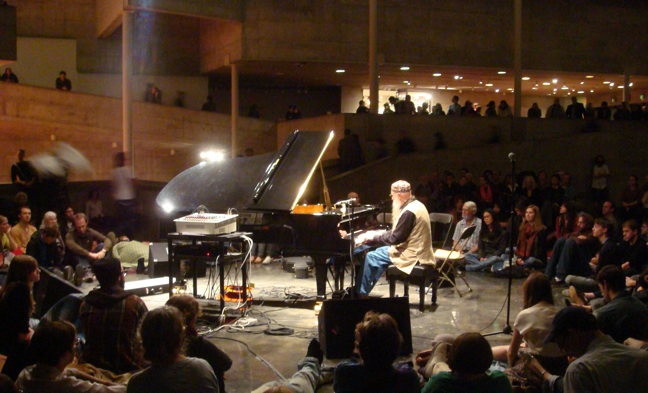Now in his 70’s, composer Terry Riley remains a musical adventurer. Friday night Nov. 6, he helped cook up a late night “happening” at the Berkeley Art Museum. Told to bring sleeping bags or pillows to the $5 concert, we sat or lay on the concrete floor. I gazed up at the concrete rectilinear forms jutting out into space—some forms fanciful, others a little ominous, as support columns have recently been added along one side.
Berkeley Pianist and local celebrity Sarah Cahill was asked to run the First Friday series, and Terry Riley’s appearance marked the inauguration. As she introduced him, latecomers crowded in to the lower level with the piano, or leaned over the concrete parapets of the higher levels and looked down. They settled in for a siege, as the program lasted from 9 p.m. to midnight.
The lower level is where the Modern collection is usually kept, but it had been cleared out to make room for a new installation. A delay left the space bare, adding an edgy warehouse air to the event.
Riley opened the long evening with an Eastern European scale, and then broke it into arpeggios. He was slow, accidental, interior and golden. The piano, donated by the Piedmont Piano Company, was a burnished brown in the gray space, circled by petals of prone bodies. The reverberant sound was so live it was almost scary, reflecting the sharp geometries and hard surfaces. But each note was legible in the large scaled spaces, and Riley even used pedal for a thick bottom scumble. The effect was a dilation of the moment, giving immediacy and sense of ritual to the work.
Pounding fourths built and broke over a beach of fragile graced notes. Riley wandered up and down the keyboard and finally settled in rounded twitters at the top. Then his left hand began to pulse under the twitter and built to eventually dominate it.
Classified as contemporary classical, his sound was rooted in jazz even as the material played with Indian ragas. It was a cross-genre improvisation by a master composer in his element, and reminiscent of his early experiments—in the 60’s Riley performed harmonium and looped sax concerts that lasted until dawn.
Riley was a disciple of North Indian classical vocal master Pandit Pran Nath, and the fruits were evident after he was joined by guitar. As guitar carried a tambura-like pulse, Riley added a vocal element. His singing was hoarse and free of self-consciousness, with open vowels turning to ululations deep in the throat. Like his teacher, the notes felt tuned to a higher level, breath and sound pointing to existence as vibration. “Lakshmi,” I think he growled into the mike, perhaps the name of one piece, or an invocation to the Hindu Goddess. “Lakshmi” derives from the Sanskrit word for perceiving.
Jazz and poly-tonality rambled across his keyboard, along with fractal elements of decay. Tired families began to leave during a smoky jazz raga. After midnight, he acceded to applause with unflagging energy, and his driving chords echoed off the concrete.
—Adam Broner
This article originally appeared in the Piedmont Post.
The First Friday series continues Dec 4 at 7:30 with composer and sculptor Ellen Fullman, who will install a 60-foot “long-stringed instrument” in the museum and play it with rosined fingers, turning Gallery B into an exotic resonating chamber. Mark your calendars! (www.bampfa.berkeley.edu.)
Photo: Terry Riley at Berkeley Art Museum Nov. 6; photo by Sara Sackner.
